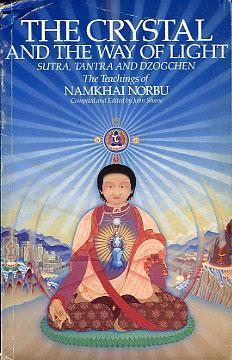
2008/12/12 Fri., cloudy, indoor 22.1°C 《水晶與光道》英文版:密宗四派都有大圓滿
就今日所讀的《水晶與光道》英文版內容,釐清兩點:其一是藏密佛教文化之所以如此繁複;其二,大圓滿不限密宗寧瑪派傳承。當然講到寧瑪派就一定要提到蓮花生大士(Padmasambhava),因為正是他在西元八世紀將佛教引入西藏。
南開諾布仁波切解釋,蓮花生大士出生於烏諦雅那國(Urgyan)(註:因為南開諾布仁波切主要在義大利弘法,所以我猜想他使用的英文是拉丁文,所以本書所列專有名詞,與真正通用的或有差異),西藏當時的本土宗教為崇尚地方神靈的苯教(Bon);南開諾布仁波切說蓮花生大士直接從噶拉‧多傑(Garab Dorje 極喜金剛,人間第一位大圓滿祖師)處獲得大圓滿境相傳承(visionary transmission of Dzogchen),同樣從噶拉多傑的傳承弟子(指的是師利星哈)處獲得口耳傳承(oral transmission );隨後蓮花生大士行至印度,吸收與掌握了密續教法(tantric trachings),成為成就者(siddha)。後來蓮花生大士利用神通力降伏西藏地方神靈成為護法(Guardians),他不認為有必要否決西藏地方傳統價值,因此融合而成獨特的藏傳佛教特色。(pp. 36-40)
我之前所質疑佛教有提到護法神這件事的原委,就是來自藏傳佛教扎根於地方宗教——苯教——所形成的樣貌,是藏傳佛教有祭祀護法神的習慣,倒不見得其他南傳或北傳佛教都祭拜護法。第二個,不是只有寧瑪派有大圓滿教法:
One must be careful to avoid the mistake, however, of thinking that the Dzogchen teachings are a school or sect 教派, in themselves, or that they belong to any school or sect. What is meant by 'Dzogchen' is always the primordial 原初的 state. And although a lineage of transmission of this state from master to disciple does indeed exist, members of that lineage, all equally practitioners of Dzogchen, could be and still can be found in all the schools of Tibetan Buddhism, or among the practitioners of Bon, or belonging to no school or sect at all. (The Crystal and the Way of Light, p. 40)
南開諾布仁波切這裡強調大圓滿是一種狀態,而非學派或教派。藏傳佛很早前便教吸收了大圓滿的教法延續至今,因此易被貼上(前弘期舊譯派)寧瑪派的標籤,但大圓滿並非僅屬於寧瑪派。寧瑪派大圓滿傑出代表人包括龍欽饒絳巴(Lonqen Rabjemba, 1303-63)、吉美林巴(Jimmed Linba, 1729-98);南開諾布仁波切這裡提到第三世噶瑪巴,其整合了大手印教法與大圓滿阿底瑜伽傳統,成立獨立的傳承體系噶舉派;再來是薩迦派,遵循來自 India Mahasiddha 傳統,也有修行大圓滿傑出的例子;最後是格魯派,亦包含許多大圓滿導師,第五世達賴喇嘛(1617-82)就是其一。(p. 41)
當翻譯官好辛苦啊,費時半天只寫了這麼一點。結論:
So it should, in general, be remembered that masters with principal allegiance to the one school, whilst fully maintaining that commitment, nevertheless freely received transmission form other traditions, and this in fact brought about a great cross fertilization in Tibetan spiritual life and culture. (The Crystal and the Way of Light, pp. 43-44)